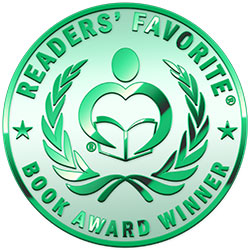
 This author participates in the Readers' Favorite Free Book Program, which is open to all readers and is completely free. The author will provide you with a free copy of their book in exchange for an honest review. You and the author will discuss what sites you will post your review to and what kind of copy of the book you would like to receive (eBook, PDF, Word, paperback, etc.). To begin, click the purple email icon to send this author a private email.
This author participates in the Readers' Favorite Free Book Program, which is open to all readers and is completely free. The author will provide you with a free copy of their book in exchange for an honest review. You and the author will discuss what sites you will post your review to and what kind of copy of the book you would like to receive (eBook, PDF, Word, paperback, etc.). To begin, click the purple email icon to send this author a private email.
![]() This author participates in the Readers' Favorite Book Review Exchange Program, which is open to all authors and is completely free. Simply put, you agree to provide an honest review an author's book in exchange for the author doing the same for you. What sites your reviews are posted on (B&N, Amazon, etc.) and whether you send digital (eBook, PDF, Word, etc.) or hard copies of your books to each other for review is up to you. To begin, click the purple email icon to send this author a private email, and be sure to describe your book or include a link to your Readers' Favorite review page or Amazon page.
This author participates in the Readers' Favorite Book Review Exchange Program, which is open to all authors and is completely free. Simply put, you agree to provide an honest review an author's book in exchange for the author doing the same for you. What sites your reviews are posted on (B&N, Amazon, etc.) and whether you send digital (eBook, PDF, Word, etc.) or hard copies of your books to each other for review is up to you. To begin, click the purple email icon to send this author a private email, and be sure to describe your book or include a link to your Readers' Favorite review page or Amazon page.
![]() This author participates in the Readers' Favorite Book Donation Program, which was created to help nonprofit and charitable organizations (schools, libraries, convalescent homes, soldier donation programs, etc.) by providing them with free books and to help authors garner more exposure for their work. This author is willing to donate free copies of their book in exchange for reviews (if circumstances allow) and the knowledge that their book is being read and enjoyed. To begin, click the purple email icon to send this author a private email. Be sure to tell the author who you are, what organization you are with, how many books you need, how they will be used, and the number of reviews, if any, you would be able to provide.
This author participates in the Readers' Favorite Book Donation Program, which was created to help nonprofit and charitable organizations (schools, libraries, convalescent homes, soldier donation programs, etc.) by providing them with free books and to help authors garner more exposure for their work. This author is willing to donate free copies of their book in exchange for reviews (if circumstances allow) and the knowledge that their book is being read and enjoyed. To begin, click the purple email icon to send this author a private email. Be sure to tell the author who you are, what organization you are with, how many books you need, how they will be used, and the number of reviews, if any, you would be able to provide.

Reviewed by Alice DiNizo for Readers' Favorite
The year was 1944 and twenty year old Rudolph Meier was a Nazi POW working in local cotton fields while he was held at Camp Papago Park near Phoenix, Arizona. He was serving as a radio operator on a German submarine stationed near the eastern coast of the United States. After it was bombed the survivors were taken captive. Rudolph, or Rudi, still believes in Adolph Hitler and the Third Reich of Germany; he was convinced that Hitler had put food on the Germans' tables, given them work, and made life better for them than it was under the Wiemar Republic and the injustice it brought Germany from the Treaty of Versailles. Rudi was a twelve year old boy when he became a willing member of the Hitler Youth, despite the unspoken caution of his grandparents with whom he lived. He even had a swastika tattooed on his right arm. As a POW, Rudi met Bob Feller and his mother and sickly father Vern who owned the cotton farm where he worked. Rudi was adamant in his beliefs that America is a country of mixed races with a foolish love of individual freedom. Then, he got to know the Fellers, who were Jewish, and watched the American guards at Papago Park. Will Rudolph Meier rethink his hardened beliefs and the intolerance of other people and their cultures?
"The Swastika Tattoo" by Geraldine Birch is a brilliant, extremely well-written book that demonstrates how a young German POW, indoctrinated by his school teachers and leaders came to question the intolerance of other people and cultures. The characters and dialogue are fine. Rudolph, Bob Feller and his mother, Ruth, Rudi's friends, his grandfather and grandmother and all the other characters are all believable and highly relevant in the story. The plot proceeds realistically to the story's end. The author's glossary of German words and their meaning is a terrific asset to readers. The essay questions help reinforce the message behind this book. This book is a potential classic, for it portrays the world so accurately.